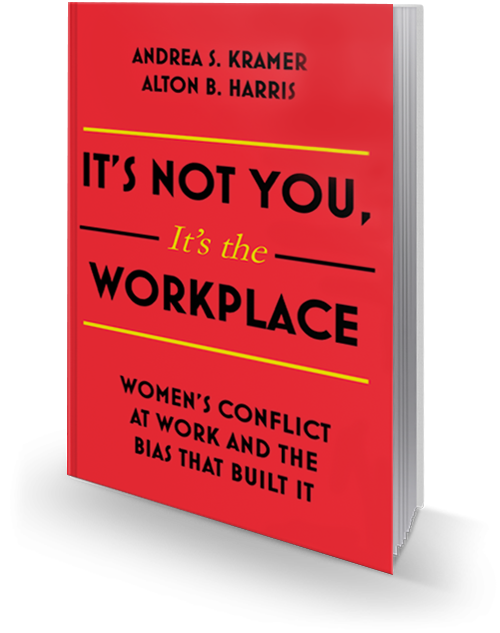
Introducing Our New Book!
It’s Not You, It’s the Workplace: Women’s Conflict at Work and the Bias that Built It is at the publisher. The editing and proofreading are finished; now the production and marketing begin. The book will be formally released August 27, but we will be distributing copies of it at our workshops beginning in July. Between now and then, we plan to write a series of blog posts on many of the topics we discuss in the book. These posts will go out with our newsletters and will be available on our website.
We decided to write It’s Not You, It’s the Workplace because so many women across the country emailed us, commented on our website, or came up to us after one of our speeches and said something like, “You are absolutely right about gender stereotypes and bias holding women back, but you also need to talk about women’s meanness to [competitiveness with, hostility toward, antagonism to] other women. I get along fine with the men I work with; it’s the women who are the problem.” After we had heard this sort of comment a great many times, we realized we needed to look at the issue in real depth. So we began reading comprehensively in the social science research, conducting our own surveys, and interviewing hundreds of women in many career fields. It’s Not You, It’s the Workplace is the result of our almost two-year investigation.
We reached three preliminary conclusions. First, women have no more intense or frequent conflicts with other women than men do with other men. Second, there is no evidence that women are more mean-spirited in their dealings with other women than men are in their dealings with other men. And third, such evidence as is available points not to women being inherently hostile to other women, but to their desire to be supportive of and advocates for each other.
So why is there such a disconnect? If women really want to support other women, why do so many of them regard their same-gender workplace relations as fraught? What we found, not surprisingly—at least for us—was that this disconnect is the result of gender stereotypes and the assumptions they foster. For example, women have very different expectations of their workplace relations with other women than they do of their relations with men. Women expect the women they work with to behave toward them in communal ways, that is, to be caring, helpful, interested, and close.
As a result, when women behave toward other women in a formal, “all business” manner—precisely the same way men behave toward them—these women, but not the men, are often seen as cold, selfish, and unpleasant. In other words, because women think about the ways in which women should relate to each other in stereotypical terms, there is an asymmetry in women’s expectation of their workplace relations with women and with men. Accordingly, senior women who do their jobs in perfectly professional ways can still be seen by junior women as hostile and people they don’t want to work for.
There is another reason for the disconnect between women’s desire to be supportive of other women and their difficulties in achieving positive same-gender workplace relationships. Women pursuing careers in traditionally male fields are typically working in highly gendered organizations. By that, we mean that these organizations are by-and-large controlled by men and characterized by masculine norms, values, and expectations. As a result, women experience more serious career obstacles than do men: more limited career-enhancing opportunities, more critical evaluations of their performance, and fewer rewards for their accomplishments.
Pervasive gender biases create these obstacles; they also often make it difficult for women to achieve positive, conflict-free same-gender workplace relationships. Frequently, in gendered organizations, there are only a limited number of “women’s seats” at the leadership table forcing women into direct competition with other women to move up. In addition, because career advancement in gendered organizations often depends on women identifying with and conforming their attitudes to the norms and values of the male-ingroup, women often distance themselves from other women in an effort to be seen as potential leaders. Moreover, because women are operating in environments in which the pervasive assumption is that they are not as “good” as men—not as valued, capable, and committed—women can internalize this assumption and seek to identify themselves as different from other women whom they treat as not having the “right stuff” needed to move up.
Women, thus, come into conflict with other women because they view them as selfish, competitive, or “losers.” They have these views not because women have some inherent or uniquely female characteristic that makes them antagonistic. Rather, the dynamics created by gendered workplaces force women into situations in which women become adversaries and same-gender conflict can seem inevitable.
It is also important to realize women worry much more about their workplace relationships with other women than men do about their workplace relationships with other men. Because most women want to have positive workplace relationships with other women, when those relationships are marked by tension and unpleasantness, women can be deeply concerned and skeptical about the possibility of constructive, supportive, and satisfying same-gender relationships.
We hope that after reading our blog posts—and eventually It’s Not You, It’s the Workplace—women will stop blaming themselves and their women colleagues when their same-gender relationships go awry, and instead focus on the structural features of the organizations for which they work. It is not the women but the workplace that makes sisterhood so difficult.

